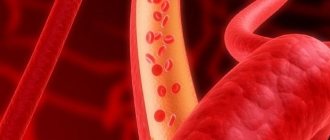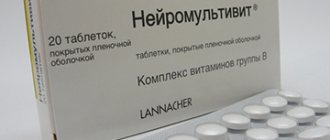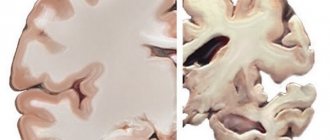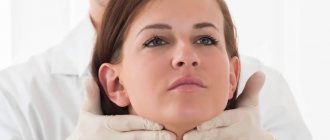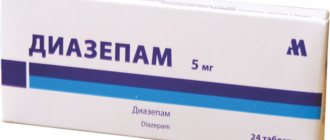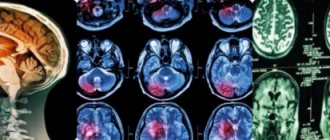5
(3)
Vitamins for the nervous system are prescribed by neurologists for various diseases - multiple sclerosis, polyneuropathy, vegetative-vascular dystonia, alcoholic, toxic encephalopathy. These compounds improve metabolism in neurons and promote the process of transmitting nerve impulses along conductive fibers.
- For adults
Vitamins for restoring the nervous system can only be prescribed by neurologists.
Causes of nervous system disorders
Disorders of the peripheral and central nervous systems occur for the following reasons:
- Injuries - concussions, brain contusions.
- Infectious processes - neurosyphilis, meningoencephalitis of viral and bacterial origin, tuberculosis.
- Hereditary diseases.
- Hydrocephalus.
- Toxic encephalopathy in case of poisoning with alcohol, methyl alcohol, heavy metals (mercury, lead), gasoline, carbon monoxide, endogenous poisons in renal and liver failure.
- Hypoxia (oxygen deficiency) caused by poor blood circulation due to vascular atherosclerosis, vegetative-vascular dystonia, lack of oxygen due to diseases of the bronchopulmonary system, suffocation.
- Endocrine disorders - diabetic microangiopathy of peripheral vessels, hyper- and hypothyroidism.
- Oncological diseases of the brain and peripheral nerves.
- Overwork.
- Lack of nutrients - amino acids, vitamins.
List of drugs in alphabetical order
Today, many people take drugs to treat the nervous system. This is due to the fact that stress, overexertion, and various disorders have become constant companions of modern man. Our nervous system needs help. If you notice even such minor symptoms as anxiety, irritability, insomnia, headaches, decreased performance, you need to consult a doctor. Only an experienced specialist is able to correctly diagnose and prescribe adequate treatment. It is also worth remembering that often medications for the treatment of the nervous system are prescribed in combination. Pills alone will not give the desired result!
A huge variety of drugs for the treatment of the nervous system
The entire list of medications for the treatment of the nervous system should be divided into:
• anesthetics – such drugs have the ability to cause anesthesia; they “turn off” the sensation of pain in a specific area; • analgesics (“painkillers”) – these drugs can be of natural, semi-synthetic or synthetic origin and are aimed at relieving pain; • antiepileptic drugs – these drugs are used to treat epilepsy, relieve muscle cramps of various origins; • antiparkinsonian drugs - such drugs are used to treat Parkinson's disease and parkinsonism; their action is aimed at increasing the level of dopamine (neurotransmitter) in the central nervous system; • psycholeptics (sedatives) – they reduce emotional stress and cause calm; it is these drugs that we most often resort to in order to balance the nervous system, relax, and improve sleep; good tolerability and the absence of serious side effects allow them to be prescribed even to elderly patients and children; • psychoanaleptics – such substances stimulate the nervous system; they can increase physical and mental activity; increase performance.
Do you suffer from neuroses or other diseases, do you feel drowsy, depressed, or, on the contrary, are you too aggressive and overly emotional? See your doctor. He will prescribe drugs for the treatment of the peripheral nervous system in a complex, which you will certainly find in our assortment. We guarantee the high quality of all drugs and the availability of the necessary certificates.
Common symptoms
Disorders of the central nervous system are accompanied by symptoms:
One of the most common symptoms of a central nervous system disorder is dizziness.
- Nausea, vomiting, which does not improve. This is typical for hypertensive encephalopathy in traumatic brain injuries and tumors of the central nervous system.
- Dementia, senile dementia, complete or partial memory loss.
- Fainting, dizziness.
- Spastic or flaccid paralysis of the limbs due to hemorrhage in the brain.
- Anesthesia (loss of sensation) of certain parts of the body.
- Cock gait due to vitamin B12 deficiency is a disorder of the spinal cord.
- Depression.
Malfunctions in the peripheral nervous system are characterized by the following symptoms:
- Impaired sensitivity of the skin in certain areas - goosebumps, numbness, tingling.
- Dysfunction of internal organs - intestines, urinary and gall bladders.
Features of prescribing drugs for VSD
The pathogenesis of the development of symptoms of vegetative-vascular dystonia is based on an imbalance between the work of the sympathetic and parasympathetic parts of the autonomic nervous system.
For reference. With VSD, there are no pronounced hormonal disorders, organic pathologies of the gastrointestinal tract (ulcer, gastritis), cardiovascular system (heart defects, myocarditis, endocarditis, severe forms of atherosclerosis), cerebral circulation disorders associated with atherosclerosis, thrombosis.
In this regard, treatment of VSD does not require the prescription of hormonal therapy, complex antihypertensive therapy, cardiac glycosides and long courses of tranquilizers.
Treatment of VSD begins with the use of the most gentle medications that help eliminate risk factors for the development of VSD and quickly relieve symptoms.
For reference. For example, among sedative drugs, the use of herbal remedies and complexes with B vitamins and magnesium is recommended. Tranquilizers, sleeping pills and antidepressants are used in short courses in the presence of concomitant severe neuroses.
In parallel with the prescription of tablets, for vegetative-vascular dystonia the following are recommended:
- dosed physical activity;
- cessation of smoking and alcohol abuse;
- normalization of sleep and rest patterns;
- adequate sleep more than 7 hours a day;
- massage;
- breathing exercises;
- good nutrition;
- swimming, walks in the fresh air, dancing, outdoor games;
- reflexology (acupuncture, acupressure).
Vitamins to strengthen the nervous system
Vitamins to maintain the health of the central and peripheral nervous systems are used both in combination and separately. For neurological disorders, vitamins of different groups are used - A, B, C, D, E.
Vitamins of groups A, B, E, D
Vitamin A is useful for maintaining a good mood, eliminating neurasthenia and depression.
Vitamin A improves mood.
B vitamins are a large group that includes:
- Thiamine.
- Riboflavin.
- Nicotinic acid and nicotinamide.
- Choline (B4).
- Pantothenic acid.
- Pyridoxine.
- Biotin (B7).
- Inositol (B8).
- Folic acid.
- Para-aminobenzoic acid (B10),
- L-carnitine (B11).
- AT 12.
- B13 - orotic acid.
- Pyrroloquinoline quinone - B14.
- B15 - pangamic acid.
- Dimethylglycine - B16.
Thiamine is a vitamin necessary for the normal functioning of the peripheral and central nervous systems. Its deficiency is observed in chronic alcohol intoxication and unbalanced diet. Hypovitaminosis leads to Wernicke's encephalopathy with Korsakoff's psychosis, beriberi disease. Thiamine has a weak ganglion-blocking effect.
Riboflavin is an important participant in the redox reactions that occur in every neuron. Promotes the formation of vitamins B6 and B9 in the body itself.
B3 - nicotinamide and nicotinic acid. Promotes the production of serotonin, activation of the parasympathetic nervous system, responsible for digestive function and restoration of the body.
Vitamin B3 promotes the release of serotonin.
B4, or choline, is a vitamin necessary for the synthesis of acetylcholine, a neurotransmitter required for neuromuscular transmission and the functioning of the parasympathetic nervous system. With its deficiency, muscle weakness occurs. Pantothenic acid is a compound of the amino acid beta-alanine and pantoic acid. When entering the body, it is included in the composition of coenzyme A, which is involved in oxidation and acetylation. Pantothenic acid is needed for the synthesis of acetylcholine.
Pyridoxine is involved in the synthesis of neurotransmitters such as dopamine, adrenaline, norepinephrine, and serotonin. If it is deficient, a person may experience depression.
Biotin regulates blood glucose levels, which is useful in the treatment of diabetic polyneuropathy. Enhances the effect of folic acid and cobalamin.
Inositol supports neuronal metabolism. Researchers have noticed its effectiveness in the treatment of mental disorders manifested by insomnia, irritability, and panic attacks. This vitamin helps reduce blood glucose levels, preventing the development of diabetic polyneuropathy.
Folic acid is needed for the formation of the neural tube - the rudiment of the spinal cord. If there is a deficiency of this substance in the body of a pregnant woman, her baby will develop a spinal cord split.
If a pregnant woman’s body does not have enough folic acid, the baby’s spinal cord splits.
Para-aminobenzoic acid increases the resistance of neurons to oxygen starvation.
L-carnitine is prescribed for multiple sclerosis to improve muscle tone in flaccid paralysis.
B12 is an essential nutrient for the central nervous system and PNS. It is needed to maintain the activity of the spinal cord and is involved in hematopoiesis (prevents anemia and the hypoxia it causes).
Orotic acid is actively involved in the metabolism of nerve cells and promotes the synthesis of neurotransmitters.
Pyrroloquinoline quinone prevents early memory loss in older people and has neuroprotective properties.
Pangamic acid consists of gluconic acid and dimethylglycine. Reduces blood pressure, useful for hypertensive encephalopathy.
Dimethylglycine is a precursor of acetylcholine. Necessary for effective neuromuscular transmission and normal functioning of the parasympathetic nervous system.
Ascorbic acid is a natural antidepressant and improves mood.
Vitamin E is an antioxidant that protects neurons from aging and oxidation by free radicals.
Vitamin E protects against aging.
Vitamin D reduces the risk of developing multiple sclerosis, a disease of northern countries with a lack of sunlight. Multiple sclerosis, caused by a malfunction of the immune system, leads to paralysis and loss of sensitivity. This is an autoimmune disease, the treatment regimen of which includes cholecalciferol.
“FARMIndex-Practik” issue 2 year 2001 pp. 19-41
CNS stimulants include drugs that can increase mental and physical performance, endurance, reaction speed, eliminate feelings of fatigue and drowsiness, increase attention span, memory ability and speed of information processing . The most unpleasant characteristics of this group are general fatigue of the body that occurs after the cessation of their influence, a decrease in motivation and performance, as well as a strong psychological dependence that arises relatively quickly. Among the mobilizing type stimulants, the following groups of drugs can be distinguished:
1. Adrenergic agonists of indirect or mixed action:
- phenylalkylamines: amphetamine (phenamine), methamphetamine (pervitin), centedrine and pyriditol;
- piperidine derivatives: meridyl;
- sydnonimine derivatives: mesocarb (sydnocarb), sydnophen;
- purine derivatives: caffeine (caffeine sodium benzoate).
2. Analeptics:
- · acting primarily on the respiratory and vasomotor centers: bemegride, camphor, niketamide (cordiamin), etimizol, lobeline;
- · acting primarily on the spinal cord: strychnine, securinine, echinopsin.
Phenylalkylamines are the closest synthetic analogues of the world-famous psychostimulant - cocaine, but differ from it in less euphoria and a stronger stimulating effect. They are capable of inducing extraordinary elation, a desire for activity, eliminate the feeling of fatigue, create a feeling of vigor, clarity of mind and ease of movement, quick intelligence, confidence in one’s strengths and abilities. The effect of phenylalkylamines is accompanied by an elevated mood. The use of amphetamine began during World War II as a means to relieve fatigue, combat sleep, and increase alertness; then phenylalkylamines entered psychotherapeutic practice and gained mass popularity. The mechanism of action of phenylalkylamines is the activation of adrenergic transmission of nerve impulses at all levels of the central nervous system and in the executive organs due to:
- · displacement of norepinephrine and dopamine into the synaptic cleft from the easily mobilized pool of presynaptic endings;
- · increased release of adrenaline from chromaffin cells of the adrenal medulla into the blood;
- · inhibition of the reverse neuronal uptake of catecholamines from the synaptic cleft;
- · reversible competitive inhibition of MAO.
Phenylalkylamines easily penetrate the BBB and are not inactivated by COMT and MAO.
They implement the sympatho-adrenal mechanism of urgent adaptation of the body to emergency conditions. Under conditions of prolonged tension of the adrenergic system, under severe stress, debilitating loads, and in a state of fatigue, the use of these drugs can lead to depletion of the catecholamine depot and disruption of adaptation. Phenylalkylamines have psychostimulating, actoprotective, anorexigenic and hypertensive effects. Drugs in this group are characterized by accelerated metabolism, activation of lipolysis, increased body temperature and oxygen consumption, and decreased resistance to hypoxia and hyperthermia. During physical activity, lactate increases excessively, which indicates inadequate expenditure of energy resources. Phenylalkylamines suppress appetite, cause constriction of blood vessels and increase blood pressure. Dry mouth, dilated pupils, and rapid pulse are observed. Breathing deepens and ventilation of the lungs increases. Methamphetamine has a more pronounced effect on peripheral vessels. Phenylalkylamines are used in very small doses in the United States to treat sexual disorders. Methamphetamine causes a sharp increase in libido and sexual potency, although amphetamine has little activity. Table 1. Main advantages and disadvantages of phenylalkylamines
| INN | Advantages | Flaws |
| Amphetamine, Methamphetamine, Centedrine, Pyridrol | Fatigue decreases, drowsiness disappears, mood improves, mild euphoria, determination and desire to work appear. | Attention is scattered, patience is lost. |
| The rhythm accelerates and the volume of operator activity increases. | With a general acceleration of mental activity, the number of errors increases. | |
| The duration of storing events in short-term memory increases. | Transfer to long-term memory improves little | |
| Stereotyped work that does not require deep thought is performed better. | As the dose increases, euphoria increases and it becomes difficult to concentrate and perform creative work. | |
| In patients with psychasthenia, normalization of mental activity is possible. | In people with mental disorders, delusional ideas, agitation, mania, hallucinations intensify, and antisocial behavior worsens. | |
| They can delay the need for sleep by 10-12 hours. | After performing an increased amount of work, long and complete rest is necessary. | |
| Weaken the effect of drugs that depress the nervous system. | They suppress the process of falling asleep and block the REM sleep phase; at the end of the drug's effect, with continued work, a rebound phenomenon may develop - elements of REM sleep against the background of wakefulness (dreams, hallucinations). | |
| Drug addiction |
Phenylalkylamines are indicated:
- · for a temporary rapid increase in mental performance (operator activity) in emergency conditions;
- · for a one-time increase in physical endurance in extreme conditions (rescue operations);
- · to weaken the side psychosedative effect of drugs that depress the central nervous system;
- · for the treatment of enuresis, adynamia, depression, withdrawal syndrome in chronic alcoholism.
In psychoneurological practice, amphetamine is used to a limited extent in the treatment of narcolepsy, the consequences of encephalitis and other diseases accompanied by drowsiness, lethargy, apathy, and asthenia.
For depression, the drug is ineffective and inferior to antidepressants. The following drug interactions are possible for amphetamine:
·
- enhancing pain relief and reducing the sedative effect of narcotic analgesics;
- · weakening of the peripheral sympathomimetic effects of amphetamine under the influence of tricyclic depressants due to the blockade of amphetamine entry into adrenergic axons, as well as an increase in the central stimulating effect of amphetamine due to a decrease in its inactivation in the liver;
- · it is possible to potentiate the euphoric effect when used in combination with barbiturates, which increases the likelihood of developing drug dependence;
- Lithium preparations can reduce the psychostimulant and anorexigenic effects of amphetamine;
- · neuroleptic drugs also reduce the psychostimulant and anorexigenic effect of amphetamine by blocking dopamine receptors and can be used for amphetamine poisoning;
- amphetamine reduces the antipsychotic effect of phenothiazine derivatives;
- · amphetamine increases the body's endurance to the action of ethyl alcohol (although the inhibition of motor activity remains);
- · under the influence of amphetamine, the hypotensive effect of clonidine decreases; Amphetamine enhances the stimulating effect of midantan on the central nervous system.
Side effects
include tachycardia, hypertension, arrhythmias, addiction, drug dependence, exacerbation of anxiety, tension, delirium, hallucinations, and sleep disturbances. With repeated use, depletion of the nervous system, disruption of the regulation of cardiovascular functions, and metabolic disorders are possible. Contraindications to the use of phenylalkylamines are severe cardiovascular diseases, diabetes mellitus, obesity, and productive psychopathological symptoms. Due to a variety of side effects, the main thing being the possibility of developing drug dependence, phenylalkylamines find limited use in medical practice. At the same time, the number of drug and substance abuse patients using various phenylalkylamine derivatives is constantly growing. The use of mesocarb (sydnocarb) causes a psychostimulating effect more slowly than that of amphetamine, and it is not accompanied by euphoria, speech and motor disinhibition, and does not cause such a deep depletion of the energy reserve of nerve cells. According to the mechanism of action, mesocarb is also somewhat different from amphetamine, since it stimulates mainly the noradrenergic systems of the brain, causing the release of norepinephrine from stable depots.
Table 2.
Main advantages and disadvantages of mesocarb
| INN | Advantages | Flaws | Drug interactions |
| Mesocarb | The psychostimulating effect appears gradually and is not accompanied by euphoria or motor excitement. The phenomena of addiction are less pronounced than with amphetamine. | Possible increased blood pressure, exacerbation of delusions, hallucinations, irritability, headache, sleep disorders, anorexia. Contraindicated in severe arterial hypertension, psychomotor agitation, and atherosclerosis. | Incompatible with MAO inhibitors, tricyclic antidepressants. Reduces muscle relaxation and drowsiness caused by benzodiazepine tranquilizers without reducing their anxiolytic effect. |
Unlike amphetamine, mesocarb has less pronounced stimulation with a single dose, and its gradual increase is observed from dose to dose. Sidnocarb is usually well tolerated, does not cause dependence or addiction, and its use may increase blood pressure, decrease appetite, and also hyperstimulation phenomena. Mesocarb is used for various types of asthenic conditions, after fatigue, central nervous system injuries, infections and intoxications. It is effective for sluggish schizophrenia with a predominance of asthenic disorders, withdrawal syndrome in chronic alcoholism, developmental delay in children as a result of organic lesions of the central nervous system with adynamia. Mesocarb is an effective remedy that relieves asthenic phenomena associated with the use of antipsychotic drugs and tranquilizers. Sidnofen is close in structure to mesocarb, but stimulates the central nervous system weaker and has pronounced antidepressant activity (due to a reversible inhibitory effect on MAO activity), therefore it is used for the treatment of asthenodepressive conditions. Meridil is similar to mesocarb, but is less active. Increases activity, associative abilities, has an analeptic effect.
Caffeine
is a mild psychostimulant, the effects of which are realized by inhibiting the activity of phosphodiesterase and, therefore, prolonging the life of secondary intracellular mediators, mostly cAMP and somewhat less cGMP in the central nervous system, heart, smooth muscle organs, adipose tissue, and skeletal muscles. The effect of caffeine has a number of features: it does not excite adrenergic transmission in all synapses, but enhances and prolongs the work of those neurons that are currently involved in ongoing physiological reactions and in which cyclic nucleotides are synthesized in response to the action of their mediators. There is information about the antagonism of xanthines towards endogenous purines: adenosine, inosine, hypoxanthine, which are ligands of inhibitory benzodiazepine receptors. Coffee contains substances that are antagonists of endorphins and enkephalins. Caffeine acts only on neurons that can respond to neurotransmitters by producing cyclic nucleotides. These neurons are sensitive to adrenaline, dopamine, acetylcholine, neuropeptides, and only a few neurons are sensitive to serotonin and norepinephrine.
Under the influence of caffeine the following are realized:
- · stabilization of dopaminergic transmission - psychostimulating effect;
- · stabilization of b-adrenergic transmission in the hypothalamus and medulla oblongata - increased tone of the vasomotor center;
- · stabilization of cholinergic synapses of the cortex - activation of cortical functions;
- · stabilization of cholinergic synapses of the medulla oblongata - stimulation of the respiratory center;
- · stabilization of noradrenergic transmission - increased physical endurance.
Caffeine has complex effects on the cardiovascular system.
Due to the activation of the sympathetic influence on the heart, contractility and conductivity are increased (in healthy people, when taken in small doses, the frequency of contractions may slow down due to excitation of the vagus nerve nuclei; in large doses, tachycardia may occur due to peripheral influences). Caffeine has a direct antispasmodic effect on the vascular wall in the vessels of the brain, heart, kidneys, skeletal muscles, skin, but not limbs! (stabilization of cAMP, activation of the sodium pump and hyperpolarization of membranes), increases venous tone. Caffeine increases the secretion of digestive glands, diuresis (reduces tubular reabsorption of metabolites), increases basal metabolism, glycogenolysis, lipolysis. The drug increases the level of circulating fatty acids, which promotes their oxidation and utilization. However, caffeine does not suppress appetite, but, on the contrary, stimulates it. In addition, it increases the secretion of gastric juice so that drinking caffeine without food can lead to gastritis and even peptic ulcers. Caffeine is indicated:
- · to improve mental and physical performance;
- · for emergency care for hypotension of various origins (trauma, infection, intoxication, overdose of ganglion blockers, sympatho- and adrenergic agents, deficiency of circulating blood volume);
- · with spasms of cerebral vessels;
- · in mild forms of bronchial obstruction as a bronchodilator.
The following side effects are characteristic of caffeine: increased excitability, cardiac arrhythmias, chest pain, insomnia, tachycardia, with long-term use - myocarditis, trophic disorders in the limbs, hypertension, caffeineism.
Acute caffeine poisoning produces early symptoms of anorexia, tremors and restlessness. Nausea, tachycardia, hypertension and confusion then appear. Severe intoxication can cause delirium, seizures, supraventricular and ventricular tachyarrhythmias, hypokalemia and hyperglycemia. Chronic use of high doses of caffeine can lead to nervousness, irritability, anger, persistent tremors, muscle twitching, insomnia and hyperreflexia. Contraindications to the use of the drug
states of excitement, insomnia, hypertension, atherosclerosis, glaucoma. Caffeine also has various types of drug interactions. The drug weakens the effect of central nervous system depressants, so it is possible to combine caffeine with histamine blockers, antiepileptic drugs, and tranquilizers to prevent central nervous system depression. Caffeine reduces the depression of the central nervous system caused by ethyl alcohol, but does not eliminate the impairment of psychomotor reactions (coordination of movements). Caffeine and codeine preparations are used in combination for headaches. Caffeine can enhance the analgesic effect of acetylsalicylic acid and ibuprofen, and enhances the effect of ergotamine in the treatment of migraines. In combination with midantan, it is possible to enhance the stimulating effect on the central nervous system. When taken simultaneously with cimetidine, the side effects of caffeine are likely to increase due to a decrease in its inactivation in the liver. Oral contraceptives also slow down the inactivation of caffeine in the liver, and symptoms of overdose may occur. When taken together with theophylline, the total clearance of theophylline decreases almost 2 times. If it is necessary to use drugs together, the dose of theophylline should be reduced.
Analeptics
(from the Greek analeptikos - restorative, strengthening) - a group of medicines that help restore consciousness in a patient who is in a state of fainting or coma. Among analeptic drugs, there is a group of drugs that primarily stimulate the centers of the medulla oblongata: vasomotor and respiratory. In large doses, they can stimulate the motor areas of the brain and cause seizures. In therapeutic doses they are usually used for weakening of vascular tone, collapse, respiratory depression, circulatory disorders in infectious diseases, in the postoperative period, poisoning with sleeping pills and narcotic drugs. Previously, a special subgroup of respiratory analeptics (lobeline) was identified from this group, which have a reflex stimulating effect on the respiratory center. Currently, these drugs have limited use.
Table 3. Comparative characteristics of analeptics acting on the respiratory and vasomotor centers of the brain
| INN | Advantages | Flaws | Drug interactions |
| Bemegrid | Has a direct stimulating effect on the respiratory center. In terms of analeptic activity it exceeds cordiamine and camphor. Indicated for barbiturate poisoning, to terminate anesthesia with barbiturates and thiobarbiturates and to accelerate awakening during anesthesia; with severe hypoxia. | In case of an overdose, nausea, vomiting, muscle twitching, and cramps are possible. Contraindicated in case of acute poisoning with anesthetics, sleeping pills, or in case of hypersensitivity to the drug. | When bemegride (and other analeptics) are administered against the background of an overdose of opioid analgesics, as well as in case of poisoning with H1-histamine blockers, convulsions are possible. Toxic effects may increase with an overdose of diphenine. With anesthetic agents – a bilateral reduction in effects. Analeptics are used to speed up the recovery of patients from anesthesia and in cases of minor overdose of anesthesia. |
| Camphor | Stimulates the respiratory and vasomotor centers, has a direct effect on the heart muscle, enhancing metabolic processes. Helps improve microcirculation. Used for acute and chronic heart failure. | Allergic reactions are possible. Contraindicated for epilepsy and a tendency to convulsive reactions. | |
| Niketamide | Stimulates the central nervous system, excites the respiratory and vasomotor centers. Indicated for cardiac disorders, shock, asphyxia, poisoning with narcotic drugs, hypnotics, analgesics. | In large doses, it can cause clonic convulsions. Side effects may include anxiety, muscle twitching, facial redness, itching, vomiting, and heart rhythm disturbances. Contraindicated for epilepsy and a tendency to convulsive reactions. | |
| Etimizole | Stimulates the respiratory center, has anti-inflammatory and anti-allergic properties. Improves short-term memory and mental performance. Indicated for poisoning with narcotic drugs, analgesics, during and after surgical anesthesia. | Dyspeptic symptoms, anxiety, dizziness, and sleep disturbances are possible. Contraindicated in case of psychomotor agitation. | In combination with cimetidine, the effect of etimizol is enhanced. The drug increases the analgesic activity of NSAIDs and increases the half-life of theophylline. |
| Lobelin | Reflexively stimulates the respiratory center and a number of centers of the medulla oblongata. It has a short-term effect and is indicated for reflexive cessation of breathing due to inhalation of irritating substances or carbon monoxide poisoning. | First, it briefly reduces blood pressure, then increases it. In high doses, it stimulates the vomiting center, causing respiratory depression, convulsions, and cardiac arrest. Contraindicated in case of bleeding, pulmonary edema, severe damage to the cardiovascular system, depletion of the respiratory center, hypersensitivity to the drug. | Used as part of combination drugs for smoking cessation. |
One of the safest analeptics is cordiamine
.
Its structure is similar to nicotinamide and has a weak antipellagritic effect. Cordiamine stimulates the central nervous system by direct action on the respiratory center and reflexively through the chemoreceptors of the carotid sinus. In small doses, the drug has no effect on the cardiovascular system. Toxic doses can increase blood pressure, cause tachycardia, vomiting, cough, arrhythmias, muscle rigidity, and tonic and clonic seizures. Etimizole,
in addition to stimulating the respiratory center, induces the secretion of corticoliberin in the hypothalamus, which leads to an increase in the level of glucocorticoids in the blood; inhibits phosphodiesterase, which promotes the accumulation of intracellular cAMP, enhances glycogenolysis, and activates metabolic processes in the central nervous system and muscle tissue. Inhibits the cerebral cortex, eliminates anxiety. Due to the stimulation of the adrenocorticotropic function of the pituitary gland, etimizol can be used as an anti-inflammatory agent for arthritis. Analeptics that primarily increase reflex excitability include: strychnine (an alkaloid from the seeds of the African chilibuha vine), securinine (an alkaloid from the herb of the Far Eastern shrub securinega) and echinopsin (obtained from the seeds of the common echinops). According to the mechanism of action, they are direct antagonists of the inhibitory mediator glycine, blocking receptors of brain neurons sensitive to it. Blockade of inhibitory influences leads to an increase in the flow of impulses in the afferent pathways of activation of reflex reactions. The drugs stimulate the sense organs, excite the vasomotor and respiratory centers, tone the skeletal muscles, and are indicated for paresis, paralysis, fatigue, and functional disorders of the visual apparatus.
The main effects of drugs in this group are:
- · increased muscle tone, acceleration and strengthening of motor reactions;
- · improving the functions of the pelvic organs (for paralysis and paresis, after injuries, strokes, polio);
- · increased visual and hearing acuity after intoxication, injury;
- · increase in general tone, activation of metabolic processes, functions of the endocrine glands;
- · slight increase in blood pressure and heart function.
The main indications for use in this group
are: paresis, paralysis, fatigue, asthenic conditions, functional disorders of the visual apparatus. Previously, strychnine was used to treat acute barbiturate poisoning; now the main drug used in this case is bemegride.
Securinin
less active compared to strychnine, but also much less toxic, it is also used for hypo- and asthenic forms of neurasthenia, for sexual impotence due to functional nervous disorders. An overdose of drugs causes tension in the masticatory and occipital muscles, difficulty breathing, swallowing, and attacks of clonic-tonic convulsions. They are contraindicated in case of increased convulsive readiness, bronchial asthma, thyrotoxicosis, coronary artery disease, arterial hypertension, atherosclerosis, hepatitis, glomerulonephritis. Due to their high toxicity, reflex-type analeptics are used extremely rarely and only in hospital settings.
Pharmacy vitamin complexes for nerves
Vitamin complexes sold in pharmacies help replenish the lack of substances in the body with a limited diet.
For adults
Aevit is available in capsules and ampoules.
On sale are the drugs Aevit, Neuromultivit, Milgamma, Neurovitan, Neurorubin, Combilipen, Neurostrong, Vitrum Superstress, which strengthen the central nervous system and PNS.
Aevit is a complex of retinol and tocopherol. Sold in capsules and solution in ampoules. Neuromultivit, Neurorubin, Combilipen are available both in tablets and in solution for intramuscular injection.
Contains thiamine, pyridoxine and cyanocobalamin. Prescribed for diabetic neuropathies, post-stroke conditions, encephalopathies of various origins.
Cytoflavin is available in solution for intravenous administration. Contains riboflavin, inosine, nicotinamide, succinic acid. Used for cerebral atherosclerosis.
For children
Neurologists prescribe the most effective complexes for children:
- Multitabs - contains all the essential vitamins (A, B, C, D, E) and minerals (iodine, selenium, iron, manganese, zinc, copper).
- Children's alphabet.
- Vitrum for children.
Vitamin complex Vitrum for children.
These vitamin complexes are necessary to calm hyperactive children, increase their learning ability and resistance to mental and psychological stress. Their use is indicated for ADHD, dementia, and logoneurosis.
Doctors have found a way to speed up the regeneration of nerve cells
In recent years, medical practitioners have reported an increase in the number of patients who complain of back pain. A significant proportion of these patients suffer from pain caused not by injury or inflammation, but by its consequences - the destruction of the insulating myelin layer of nerve fibers. This may be a consequence of old injuries, pathologies that have developed in internal organs, inflammation affecting the spine, or tumors. Its provocateurs are stress, metabolic imbalance, hypothermia, heavy lifting or intoxication. Such pain is called neuropathic and is considered an independent chronic disease, which most negatively affects the quality of life and psychological state of people suffering from it.
The myelin sheath of the nerve fiber performs protective, supportive, and insulating functions. When the insulating myelin layer is destroyed, the speed of signal transmission along the nerve fibers slows down and pain occurs. Treating such patients is a very difficult therapeutic task. Nonsteroidal anti-inflammatory drugs and analgesics, which are traditionally prescribed for pain, cannot help in the case of chronic neuropathic pain.
However, chronic neuropathic pain is a very common phenomenon. According to recent studies, it affects 6 to 8 percent of the population. Among them are from 30% to 40% of cancer patients, every fourth patient with diabetes, every tenth patient who has had a stroke. A significant percentage of people who consult doctors for back pain also have a disease of a neuropathic nature.
However, the protective sheath of the nerve fiber can be restored under certain conditions. The researchers noted that in the early stages of nerve damage, the uptake of uridine and cytidine increases. These are nucleotides, physiological nutrients necessary for the regeneration of nerve cells. These substances help restore nerve fibers, thereby reducing pain.
The latest generation product has opened up new possibilities for managing patients for whom drug therapy is insufficient. The specific nutraceutical Keltican® complex is similar to substances found in the body. It is used as a food supplement, is non-toxic and promotes nerve fiber regeneration. Supporting components - folic acid and vitamin B12 - are also necessary in the process of nerve regeneration. They are directly involved in the processes of metabolism of nerve fibers and the formation of the myelin sheath.
Having a high level of safety and non-addictive properties, Keltican® complex can serve as an addition to drug therapy.
Neuropathic back pain affects mainly people of socially active and working age. Most often, pain is associated with a sedentary lifestyle, sedentary work, and high levels of stress. However, while all of these factors can indeed trigger the onset of chronic neuropathic back pain, lifestyle changes will not help if the process has progressed far enough. Such patients need a remedy for the regeneration of nerve fibers, which will not conflict with other drugs.
Chronic back pain is something that about 80% of the world's population lives with, according to WHO data. This pain has a different nature, starting from incorrectly selected work furniture or neglect of orthopedic devices in people with flat feet, from stress and the environment to really serious diseases. Over the past decade, people who have to live with constant pain have received increasing attention. It is becoming generally accepted that pain is not necessarily a useful signaling tool that indicates a particular problem. Pain can be an independent disease that depletes a person’s strength and plunges him into a depressive state. Chronic back pain can and should be eliminated, doctors say, and properly selected products that can restore nerve fibers, combined with physical activity and reducing stress levels, can help in this situation.
RU .77.99.11.003. E.005541.04.15
Medicines in tablets
Neurostrong from ArtLive contains thiamine, pyridoxine, nicotinamide and flavonoids to strengthen brain vessels. They are prescribed for neurocirculatory dystonia and asthenodepressive syndrome.
Vitrum Superstress contains thiamine, riboflavin, nicotinamide, calcium pantothenate, pyridoxine, biotin, cyanocobalamin, ascorbic acid and vitamin E, ferrous fumarate. The composition contains iron and cyanocobalamin - antianemic substances that prevent a hypoxic state that threatens the death of neurons. Fumarate is an organic form of iron that is easily absorbed by the body.
Magnesium orotate calms the excited central nervous system. Orotic acid salt is used to improve metabolism, and magnesium is used to support the adrenal glands, which are responsible for responding to stress.
Metabolic agents in the treatment of VSD
Of this group of drugs, meldonium preparations (Mildronate) are most often used; L-carnitine and coenzyme 10 preparations are also taken.
For reference. Mildronate has a cardioprotective effect, normalizes cerebral circulation and metabolic processes in the myocardium and brain tissue.
The drug is used for excessive physical and emotional stress, treatment of vegetative-vascular dystonia, complex treatment of cardiomyopathies, coronary heart disease, cerebrovascular accidents (including after strokes).
Mildronate is contraindicated in case of intolerance to meldonium, pregnancy and breastfeeding, as well as in children under 18 years of age.
Dosages and duration of treatment are selected individually, depending on the severity of the patient’s condition.

